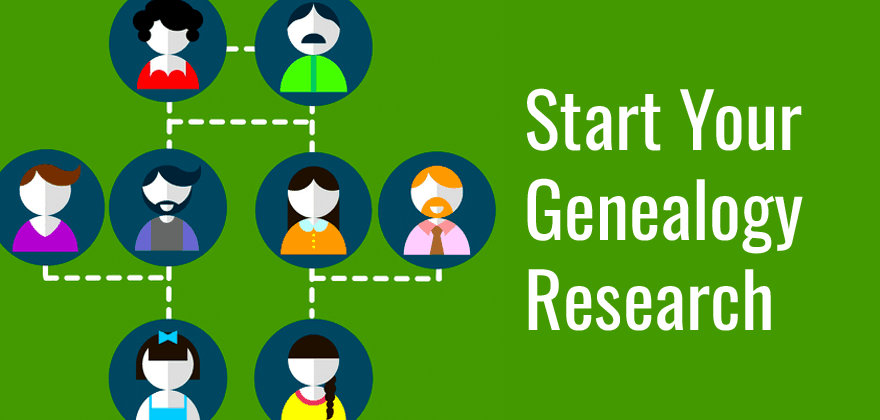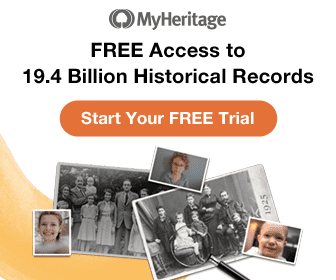Genealogy is all about recreating the lives of our ancestors using the clues they left behind.
This article is meant for beginners and will cover the basics to help get started in this rapidly growing hobby.
With the proliferation of searchable online databases, it’s tempting to just dive right into genealogy and start searching.
We call this searching – not researching.
Don’t get me wrong. Searching is a lot of fun. But’s it’s not research.
The first thing you need to do, before anything else, is establish a goal.
Trying to do research without having a goal is like trying to drive to a restaurant when you don’t know where it is.
You might get there eventually, but be ready to face a lot of delays and frustrations along the way.
You need a map, and your goal provides that map.
Setting Your First Goal
For many new genealogists, they think their first goal should be to trace their full family back as far as they can.
That sounds great, but it isn’t. That’s really your final goal, not your first one.
Limit your goal to something that you can accomplish in a reasonable amount of time. And be sure it is something you can measure.
Your first goal could be to complete a three or four-generation ancestral pedigree chart.
That means finding out all you can on yourself, your parents, your grandparents, and at least the names of your great-grandparents.
And that’s it. Don’t try to go any further yet.
Remember, this is your starting point. Once you have this first chart done, then you can set more goals to expand it further.
With each new discovery and as you grow more experienced, your goals will change.
But don’t bite off too much to start. Keep it simple. Don’t let yourself get frustrated by setting an overly ambitious goal.
And keep in mind that the ancestral chart you create now is going to be the jumping-off point for all of your future research.
Establish What You Know
Before you jump online, sit down with a pen and paper and write down what you know. Fill in as much as you can.
For each person, you’re looking for names, dates, and locations.
The absolute minimum you want for each person on your tree is their full name and when and where they were born, married, and if applicable, died.
When you record names, always use birth (maiden) names and full given names (see this article for how to find someone’s maiden name). That will avoid a lot of confusion later. You may want to indicate nicknames on your chart too, but keep in mind that most official records won’t use them.
Involve Your Family
Once you’ve hit the limit of what you know, reach out to your family. Find out what they can tell you.
If they are still alive, contact your parents, grandparents, even great-grandparents directly. They’d love to hear from you, and will be a wealth of information and stories, and often photos and documents as well.
Other older relatives, such as uncles and aunts, can help too, especially if your direct ancestors have passed away.
You may even find that someone in your family has already done a lot of genealogical research. But if you don’t talk to them and find out, you could spend countless hours duplicating all that effort!
In addition to basic family pedigree questions, you’ll also want to ask about other relationships such as friends, associates, and neighbors (known in genealogy as the FAN club). See my guide on FAN cub research.
Remember to keep track of who told you what. Ask the person how they know the information they’re giving you. Did they witness the event or just hear a rumor about it from your crazy Uncle Ned?
Even if you don’t think a certain piece of information if important right now, it may be crucial evidence in the future. So always document as much information as possible.
Some sources of information will be much more reliable and credible than others.
Keeping Records
There are dozens of genealogy software packages out there. But at this point, you shouldn’t buy any of them. Not yet.
You wouldn’t buy a car without knowing your driving habits and needs. You shouldn’t buy genealogy software without knowing your genealogical habits and needs, either.
For now, stick to pen and paper, or a simple word processing or note-taking program on your computer. With the basic information you are gathering, that is plenty for the moment.
Wait until you have a better handle on what you want from your genealogical software before you start shopping.
Online Resources
Over the last twenty years, there has been an absolute explosion of genealogy online. There are thousands of websites dedicated to genealogy and family history. Some are small and specialized, others are huge and collect billions of records together in one spot.
Two of the ones you should look at first are Ancestry.com and FamilySearch.org.
Ancestry.com
Ancestry (view website) is one of the oldest genealogy websites around, and one of the best. It houses a huge collection of searchable databases.
It also offers some features that most other sites don’t, including the ability to build your family tree online.
When you use Ancestry’s family tree builder, it automatically performs a lot of basic database searches for you. That saves time and effort and may find records you didn’t even think to look for.
To get the most out of Ancestry.com, you will need to have a paid membership. However, there are plenty of free features, and you can test before you buy with a two-week free trial.
FamilySearch.org
FamilySearch (view website) is operated by the LDS Church, but is open to everyone. The LDS Family History Centers house one of the largest genealogical collections in the world, and now much of that information is available on their website.
Like Ancestry, FamilySearch offers the ability to build your family tree online and share it with others.
I don’t recommend you use FamilySearch to store your tree simply because it’s a crowd-based system where anyone can change information. That information may or may not be accurate.
FamilySearch.org is entirely free for anyone to use.
Understanding Common Records
There are many different types of genealogical records, and they are found in many different places. As responsible genealogists, we should always conduct reasonably exhaustive research as per the genealogical proof standard. Here are a few of the records you will use most often as a beginner.
Vital Records
This includes any sort of records about major life events, such as birth, death, and marriage records.
Vital records are great for providing detailed, official information about your ancestors, including:
- Full legal name
- Date and location of birth, marriage, and/or death
- Parents’ names, and sometimes their birth dates and locations as well
- Names of spouses, children, or other relatives
Vital records can be ordered directly from the agency that stores them. In many cases, they can now be found in searchable online databases, too, like those at Ancestry and FamilySearch. You can also visit Archives and search for the records yourself.
Census Records
Every ten years since 1790, the United States has conducted a federal census. Most of those records are still available.
Many states have held additional censuses over the years, and there have been a few special federal ones as well.
Census records can be very helpful, especially because they cover such a broad range of years. They can help fill in the gaps when other records do not exist.
Among other things, census records can tell you:
- Names
- Parents and siblings
- Age, and sometimes even exact birth years, months, or dates
- Occupation
- Hints about land and property ownership
They also help you trace your ancestors’ movements over time.
Death Records
In addition to vital records like death certificates, we tend to leave other records behind as we pass away.
This includes especially obituaries and cemetery records.
Both can give you not just dates of death, but also birth dates, relatives, places lived, and much more.
In some cases, you can even find photographs of your ancestors’ gravestones, and sometimes even photos of your ancestors themselves!
Other Records
There are many other types of records out there. Some are official government records, while others might be privately held, like church records.
Examples include:
- Military service records
- Wills, probate, and other court records
- Church records, including births, baptisms and christenings, marriages, and burials
- Citizenship and naturalization applications
- Social Security records
- Land deeds
- Newspapers (see our guide to newspaper research)
- And many more
Records at Home
Don’t forget to check your own home for records, too. Look for things like:
- Birth announcements
- Wedding invitations
- Memorial service programs
- Report cards and other school records
- Your own birth certificate
- A family Bible
Photos can also be a great source, especially if someone has taken the time to jot down notes on the back about who it is, and when and where it was taken.
Your First Steps
Are you ready to get started? Here’s a quick review of the first steps you should take.
- Write down what you know. Fill out as much of a four-generation ancestral chart as you can.
- Talk to your family. Fill in the gaps. The more information you have to start with, the easier it will be to conduct effective searches in online databases.
- Sign up for an Ancestry.com account and 14-day free trial. Enter what you have so far into an online family tree.
- Use the hints Ancestry gives you to look for basic records. This not only helps you flesh out your family tree, but it also gives you a good idea of the kind of databases that you can search.
- Sign up for a free account with FamilySearch.org. Try a few searches there for birth, death, or other records that might not have shown up on Ancestry.
- Read my guide on how to structure your research.
Start Now
Digging up your family roots is easier than ever. You don’t have to be an expert. And you don’t have to devote an enormous amount of time to it, either.
Set simple goals. Start a family tree. Reach out to your relatives. But don’t wait until “someday” when you may or may not have more free time. Start your journey now.
With the wealth of online resources now available, it’s amazing what you can do with just a couple of hours.
Sign up for a free trial of Ancestry.com today and find out what the world of genealogy has in store for you.




Thank you for all your information. I’m truly grateful. You’ve made it a lot less confusing. I hope I can help others with my future learnings to start them on their journey’s.